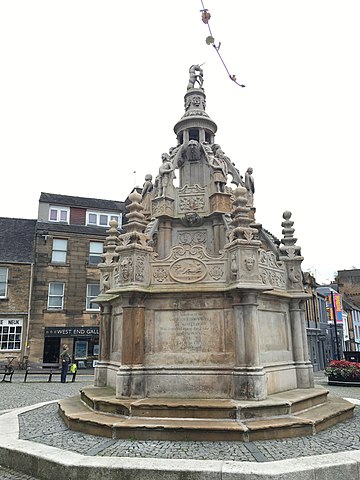Annotation:Cross Well of Edinburgh: Difference between revisions
No edit summary |
No edit summary |
||
| Line 3: | Line 3: | ||
{{TuneAnnotation | {{TuneAnnotation | ||
|f_tune_annotation_title= https://tunearch.org/wiki/Annotation:Cross_Well_of_Edinburgh > | |f_tune_annotation_title= https://tunearch.org/wiki/Annotation:Cross_Well_of_Edinburgh > | ||
|f_annotation=[[File:Crosswell.jpg|thumb|right|400px|Cross Well, Linlithgow]]'''CROSS WELL OF EDINBURGH, THE'''. Scottish, Reel (cut time). D Major. Standard tuning (fiddle). AABBCCD. John Glen (1891) finds the earliest printing of the tune in Robert Bremner's 2nd collection, 1768 (p. 110). The Cross Well, Linlithgow, was originally a spring that had been covered in 1620, a little south of its present location on High Street. It was moved when the market cross was taken away, and in 1807 in was covered by a fountain shaped like an imperial crown, built by one-armed stone mason Robert Gray. | |f_annotation=[[File:Crosswell.jpg|thumb|right|400px|Cross Well, Linlithgow]]'''CROSS WELL OF EDINBURGH, THE'''. Scottish, Reel (cut time). D Major. Standard tuning (fiddle). AABBCCD. John Glen (1891) finds the earliest printing of the tune in Robert Bremner's 2nd collection, 1768 (p. 110). The Cross Well, Linlithgow, was originally a spring that had been covered in 1620, a little south of its present location on High Street. It was moved when the market cross was taken away, and in 1807 in was covered by a fountain shaped like an imperial crown, built by one-armed stone mason Robert Gray. This was a replica of an earlier structure dating from 1628, which was destroyed during the occupation of Linlithgow by Oliver Cromwell's army but rebuilt after the restoration of King Charles II in 1660. | ||
|f_source_for_notated_version= | |f_source_for_notated_version= | ||
|f_printed_sources=Robert Bremner ('''For the year 1769 a collection of scots reels, or country dances'''), p. 110) | |f_printed_sources=Robert Bremner ('''For the year 1769 a collection of scots reels, or country dances'''), p. 110) | ||
Latest revision as of 17:27, 1 July 2023
X:1 T:Cross well of Edinburgh, The M:C| L:1/8 R:Ree; B:Robert Bremner – “For the year 1769 a collection of scots reels, or country dances” (p. 110) F:https://digital.nls.uk/special-collections-of-printed-music/archive/104994078 Z:AK/Fiddler’s Companion K:D AF (AB/c/ d)ABd|AF (AB/c/ d)F TE2|(AF)AB defd|egTfe d/d/d d2:| |:(f/g/a) (df) a>bTag|(f/g/a) (df) efTed|f/g/a (df) a>bag|fdef d/d/d d2:| |:d2 (FA) dAdf|dAFA dF TE2|d2 FA defd|egTfe d/d/d d2:| (f/g/a) da fdad|(g/a/b) eb gebe|(f/g/a) df a>bTag|fdef d/d/d d2| (f/g/a) (.d.a) fdad|(g/a/b) (.e.b) gebg|afge fdec|AgTfe d/d/d d2||


